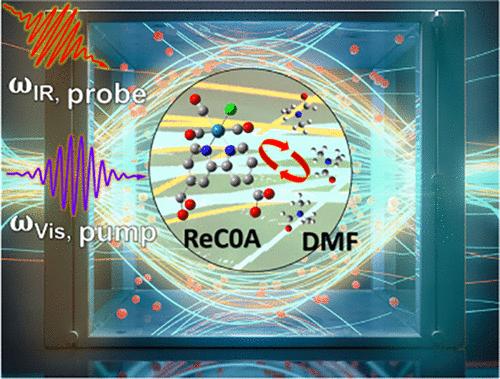振动强耦合下CO2还原催化剂的激发态动力学
IF 15.6
1区 化学
Q1 CHEMISTRY, MULTIDISCIPLINARY
引用次数: 0
摘要
分子极化子是由微腔中分子电子或振动跃迁耦合到光子模式而形成的,由于其影响化学动力学的潜力而引起了人们的兴趣。本文利用瞬态红外(IR)透射光谱研究了振动强耦合(VSC)对溶剂化诱导时相关Stokes位移的影响。在法布里-珀罗腔内400 nm激发后,利用角度分辨的振动极化谱监测了Re(bpy-COOH)(CO)3Cl配合物(ReC0A)的电子激发态动力学。我们的研究结果揭示了CO动力学Stokes位移的明显红外极化特征,我们使用基于时间相关激发态吸收模型的模拟来解释这一特征。我们观察到在VSC下CO模的溶剂化引起的振动动力学Stokes位移变化可以忽略不计。我们还研究了腔内的扰动自由感应衰变及其与极化子动力学的关系。这种设置使我们能够探测和测试潜在的基本VSC对与反应性和电荷转移相关的分子过程的影响。本文章由计算机程序翻译,如有差异,请以英文原文为准。

Excited State Dynamics of CO2 Reduction Catalyst under Vibrational Strong Coupling
Molecular polaritons, formed by coupling molecular electronic or vibrational transitions to photonic modes in microcavities, have gained interest for their potential to influence chemical dynamics. Here, we investigate the effects of vibrational strong coupling (VSC) on solvation-induced time-dependent Stokes shifts using transient infrared (IR) transmission spectroscopy. The electronic excited-state dynamics of the Re(bpy-COOH)(CO)3Cl complex (ReC0A) is monitored via angle-resolved time-dependent transmission spectra of vibrational polaritons following 400 nm excitation inside a Fabry–Perot cavity. Our results reveal distinct infrared polaritonic signatures of the CO dynamical Stokes shift, which we interpret using simulations based on a time-dependent excited-state absorption model. We observed negligible change of the solvation-induced vibrational dynamic Stokes shift of the CO modes under VSC. We also investigate the perturbed free induction decay in the cavity and its connection to polariton dynamics. This setup allows us to probe and test potential fundamental VSC effects on molecular processes relevant to the reactivity and charge transfer.
求助全文
通过发布文献求助,成功后即可免费获取论文全文。
去求助
来源期刊
CiteScore
24.40
自引率
6.00%
发文量
2398
审稿时长
1.6 months
期刊介绍:
The flagship journal of the American Chemical Society, known as the Journal of the American Chemical Society (JACS), has been a prestigious publication since its establishment in 1879. It holds a preeminent position in the field of chemistry and related interdisciplinary sciences. JACS is committed to disseminating cutting-edge research papers, covering a wide range of topics, and encompasses approximately 19,000 pages of Articles, Communications, and Perspectives annually. With a weekly publication frequency, JACS plays a vital role in advancing the field of chemistry by providing essential research.

 求助内容:
求助内容: 应助结果提醒方式:
应助结果提醒方式:


